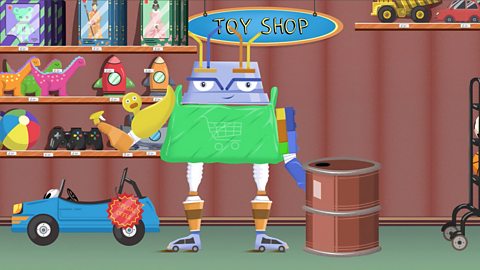Glass and sustainability
Glass is a useful material that has been around for thousands of years.
In this article you can learn:
- How glass is made
- What glass is used for
- What its environmental impact is
This resource is suitable for sustainability topics for primary school learners.
Video - Glass and sustainability
In this video, you can learn how glass is made and how sustainable it is.
Meet Glass. She’s a touch of class.
Glass can be a very modern, high-tech kind of material, but people have been making basic glass for thousands of years.
To produce it, you need lots of sand, a little limestone, some soda ash, and hot, hot heat.
If you want something that’s tough…
…most of the time…
…keeps water out… or in…
…and lets all the light through, she’s a cracking choice!
Well true, these days, you might use Plastic instead, but just because Glass is older, it doesn’t mean that she can’t keep up.
You could say that she’s the Queen of recycling, because old glass can simply be melted again, and made into new glass.
She can just keep on recycling forever.
Poor old Plastic, on the other hand, can only be recycled a few times.
Glass isn’t just used for bottles and jars either.
She can be recycled into surprising things, like insulation for houses.
But that doesn’t mean that Glass is totally sustainable.
Melting old glass needs loads of heat and melting sand for new glass needs even more!
And right now, that causes carbon emissions.
Some glass products - like lightbulbs, drinking glasses or mirrors, just can’t be recycled.
And, of course, not everybody separates out their glass into the recycling.
Some bottles and jars end up as litter, where they can harm wildlife, or even start wildfires!
Overall then, Glass gets a pretty good sustainability score – if we use her sensibly.
She’s non-toxic, reusable and very recyclable.
Though she does use a lot of energy.
How is glass made?
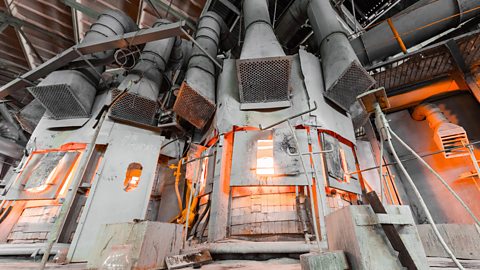
Glass is made from sand, limestone and soda ash.
The materials are heated until they melt, then shaped and cooled.
The heating process uses a lot of heat energy. Most of this is from burning gas. This causes carbon emissions that contribute to global heating and climate change.
Making glass by recycling old glass uses less emissions than making it from raw materials. This means that each time we recycle glass instead of making new glass, we are reducing our impact on the environment.
In fact, every tonne of glass re-melted saves 246kg of carbon dioxide emissions compared to production of new glass. It's even better to reuse glass when you can. That saves a lot of energy.

What is glass used for?
There are many uses for glass. Here are some examples:
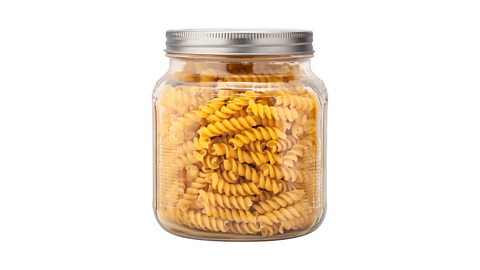
Image caption, Food storage
Glass can be sterilised and sealed to preserve food and drink so it is safe to eat or drink. (Danny Smythe / Alamy Stock Photo)
Image caption, Kitchenware
Because glass is safe to use with food and drink, it is a popular material for all sorts of kitchenware like glasses, bowls, jugs and juicers. (Frannyanne / Alamy Stock Photo)
Image caption, Lenses
Glass can be shaped to make all sorts of lenses for cameras, telescopes, microscopes and glasses. (Jonathan Brown / Alamy Stock Photo)
Image caption, Windows
Windows let light in and let us see out. Double and triple glazing windows hold gases in between glass panes. This acts as insulation, keeping our homes warm. (Tom Gowanlock / Alamy Stock Photo)
Image caption, Insulation
Glass sheeting is often used in house insulation where it can be placed in walls, floors and ceilings. (ronstik / Alamy Stock Photo)
Image caption, Surfboards
Glass particles are mixed with other materials (plastic, fibre and resin) to create a strong but light outer shell for surfboards. (Westend61 GmbH / Alamy Stock Photo)
Image caption, Fibre optic cables
Fibre optic cables are used to connect computers and broadband networks. Inside the cable are long strands of flexible glass fibre. Each strand is about the thickness of a human hair. Fibre optic cables transmit data sent as beams of light. They can do this very fast and over long distances. (Zdeněk Malý / Alamy Stock Photo)
1 of 7
Is glass environmentally friendly?
It's a little complicated.
As mentioned above, a lot of heat energy is needed to make glass. Most of this comes from burning fossil fuels. to quarryTo dig a material out from the ground. the materials used to make glass can damage the environment and cause pollution.
Glass bottles and jars are also heavier and bulkier than plastic, cardboard or metal containers. This means transporting products in glass containers can use more fuel.
Glass does not biodegrade over time either. This means that without recycling, it won’t break down naturally and will be with us forever.
However, unless it cracks or breaks, glass can be used over and over again without wearing down or needing to be thrown away.
Most glass can be recycled over and over again (apart from certain things like lightbulbs and mirrors). The recycling process uses less energy so is better for the environment. In the UK, about 70% of household glass is recycled from glass bottle banks and bin collections.
It is really important to recycle glass separately from other materials. It can be recycled at a glass bottle bank or your local council should have glass collection recycling two or three times per month.
Remember
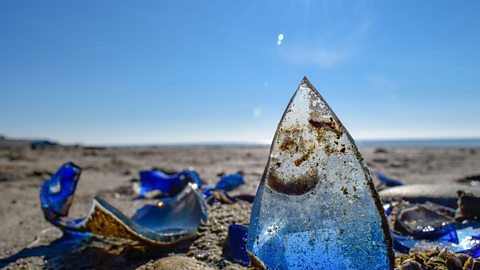
Image caption, Glass litter can injure wildlife and people
It is important to recycle or bin glass carefully. (EyeEm / Alamy Stock Photo)
Image caption, Most glass is very easy to recycle...
Glass can be recycled at bottle banks and many homes now have glass recycling bins that are collected regularly. Recycling all glass bottles and jars saves energy and natural resources. (wda bravo / Alamy Stock Photo)
Image caption, ... but some items are not recyclable
Items such as drinking glasses, mirrors and a lot of lightbulbs cannot be recycled. These should be disposed of carefully in the bin, particularly if they are broken. Newer energy-saving light bulbs are sometimes recycled separately at recycling centres so be sure to check before you bin yours. (Enrico Rubicondo / Alamy Stock Photo)
1 of 3
The advantages and disadvantages of glass
Advantages
Glass is 100% recyclable and can be reused over and over again, without losing its quality.
Most types of glass can be recycled. It doesn’t matter what shape, colour or size, all types of glass bottles and jars can be recycled.
Very little waste is generated in the glass recycling and manufacturing process. Recycled glass can be used to remake the same products as well as new products like insulation.
Every tonne of glass re-melted saves 246kg of carbon dioxide compared to making a tonne of new glass.
Glass can be to steriliseTo remove or destroy bacteria and other living microorganisms. so it is good for preserving food, drink, medicines and cosmetics.
Disadvantages
Glass does not decompose and therefore puts a great strain on landfill, which is not good for the environment.
New glass is made from four main ingredients: sand, soda, ash, and limestone. While there is no shortage of these raw materials yet, they have all been quarried, which can damage the landscape, affect the environment and use more energy.
Glass containers are heavier and bulkier than other materials, so it takes more fuel to transport them.
Not all types of glass products can be recycled. Items such as mirrors, drinking glasses and lightbulbs cannot be recycled and need to be disposed of carefully.

Key words about glass and sustainability
Sorry, something went wrongCheck your connection, refresh the page and try again. - To break down and disappear over time.
Sorry, something went wrongCheck your connection, refresh the page and try again. - To remove or destroy bacteria and other living microorganisms.
Sorry, something went wrongCheck your connection, refresh the page and try again. - Doing something that will cause little or no damage to the environment and will be able to continue for a long period of time.
Sorry, something went wrongCheck your connection, refresh the page and try again. - This is the release of carbon into the earth’s atmosphere which contributes to climate change.
Test your knowledge
Quiz
Challenge

Design a poster to encourage people to recycle their used glass
You will need to include important facts and information that will help them understand the importance of recycling glass and why they should do it.
Recycling glass is good but reusing is even better!
Find ways to reuse your old glass jars and bottles as storage jars or up-cycle and decorate them for something else!
More on Materials and resources
Find out more by working through a topic
- count7 of 7

- count1 of 7
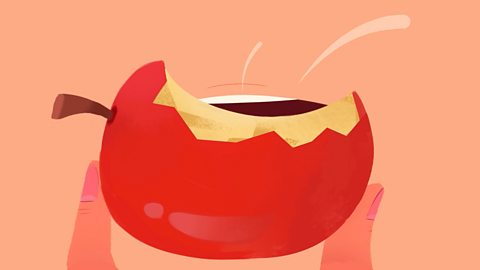
- count2 of 7
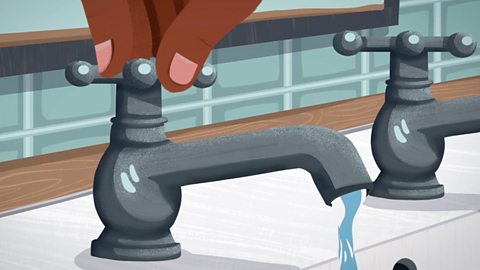
- count3 of 7
